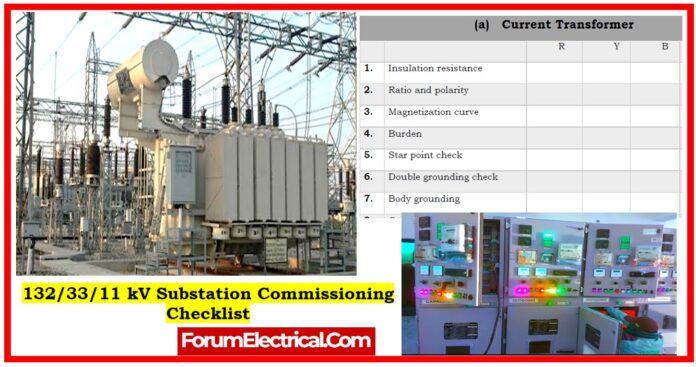Substation commissioning is an important step in power system implementation because it ensures that all equipment and protective systems are properly installed, tested, & ready for dependable operation.
This checklist covers the key components of a 132/33/11 kV substation, as well as associated testing and verification procedures.
Each stage comprises extensive tests and observations, which will be recorded throughout the commissioning process.
Before starting the operation, properly document the location, commissioning date, and exact bay being tested to provide traceability & record-keeping for future maintenance and audits.
Potential Transformer (PT) Checks
Potential transformers are tested phase-wise (R, Y, and B) for:
- Insulation Resistance is measured to validate dielectric strength.
- Ratio test: To ensure that voltage transformations are accurate.
- Burden Test: To check that the PT performs under the rated loading circumstances.
- Body/Primary Grounding: Verified for safe functioning.
- Core allocation has been confirmed for accurate wiring and phase relationship.
Current Transformer (CT) Checks
Current transformers are thoroughly checked for:
- Insulation resistance, ratio, and polarity verification.
- Magnetization Curve: To determine the CT’s saturation properties.
- Burden and Starpoint Check: To ensure that the linked load and star configuration are proper.
- Double and body grounding have been checked to prevent floating neutrals.
- Core Allocation and Unused Core Grounding: Ensures appropriate core operation and safety.
Circuit Breaker (VCB/SF6/CB) Testing
- Insulation and Contact Resistance: Ensure that there is no leakage or excessive contact loss.
- Validate operational control logic, including remote and local operations, interlocks, and anti-pumping.
- Timing Test: Determine the opening and closing speeds for trip efficiency.
- TCS Relay & Pressure Monitoring: Maintain trip command integrity & gas/oil level safety.
- Body grounding is tested in accordance with standards.
Lightning Arrester (LA) Verification
Lightning arresters are evaluated for:
- Insulation Resistance: Used to check dielectric performance.
- Counter Check: Confirms the number of surge activities.
- Body Grounding: Ensures the safe discharge of surge currents.
Isolator Checks
Isolators must be checked for both mechanical and electrical integrity.
- Insulation and Contact Resistance.
- Remote and local operation.
- Motor Current Measurement: Used to determine motor health.
- CT Switching: Verified proper connections using CTs.
Earth Switch Testing
Earth switches are tested for:
- Interlock Functionality
- Operational smoothness
- Contact Resistance
- Grounding Integrity
Relay & Control Panel Inspection
The protection & control system is evaluated by:
- Panel & Relay Body Grounding
- DC Changeover Functionality
- Cable Dressing: Ensured appropriate routing, marking, and safety.
- Battery Charger & Battery System: Required for DC backup.
- Charging Test: To check that the charger performs properly under load.
- Battery capacity and cell voltage are measured to assess performance.
- The specific gravity of the electrolyte indicates the battery’s health and charge state.
Power transformer Testing
Transformers, being the core of the substation, are extensively tested:
- Insulation and wind resistance
- HT/LT Excitation & Turn Ratio
- Magnetic Balance & Tan Delta Test
- BCT & Oil BDV Testing
- Temperature indicators (WTI/OTI)
- PRD & Buchholz Relay Functional Tests
- Arcing Horn Gap Adjustment
- Fan & Tap Changer Operations (Remote, Local, and Automatic)
- Air Release from all Valves & Valve Positioning
Commissioning Report
Following the completion of all testing, a final overall report must be created that includes:
- Observations
- Deviation (if any)
- Corrective Actions Taken









